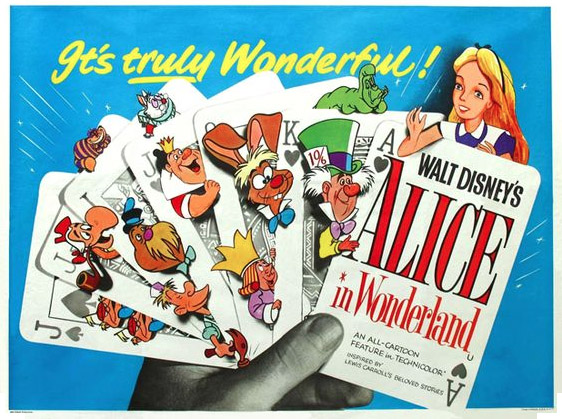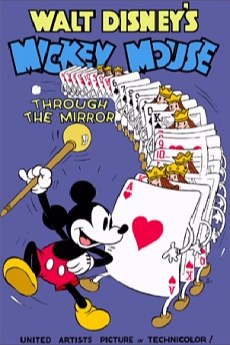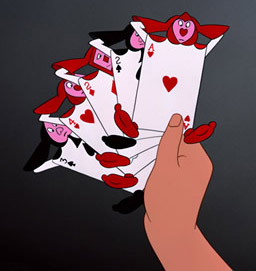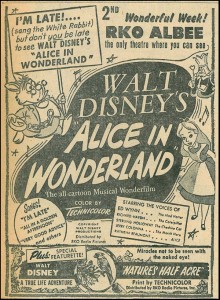
In discussing the Disney animated feature films, some of the smaller supporting characters that have added to the story or the gags are too often dismissed and forgotten. In John Grant’s very fine book, Encyclopedia of Walt Disney’s Animated Characters, where he occasionally spotlights the smaller characters, even he fails to mention the playing cards in Alice in Wonderland (1951) whose roles add much to that film.
Walt Disney had long been interested in the story of Alice, perhaps inspired by the book Animated Cartoons (1920) by E.G. Lutz that suggested the possibilities. As Walt stated in American Weekly magazine (August 11, 1946), “No story in English literature has intrigued me more than Lewis Carroll’s Alice in Wonderland. It fascinated me the first time I read it as a schoolboy and as soon as I possibly could after I started making animated cartoons, I acquired the film rights to it.”
 Even though he acquired the rights in 1938, work finally began seriously on the feature in 1949 and over the next two years, fifty thousand man-hours, 700,000 drawings and three million dollars were devoted to producing the film. Thirteen writers are credited with the story besides Carroll.
Even though he acquired the rights in 1938, work finally began seriously on the feature in 1949 and over the next two years, fifty thousand man-hours, 700,000 drawings and three million dollars were devoted to producing the film. Thirteen writers are credited with the story besides Carroll.
Alice in Wonderland had its world premiere at the Leicester Square Theatre in London on July 26, 1951. Walt attended, accompanied by a very young Kathryn Beaumont (who voiced Alice) in an Alice costume.
In one of the most beloved Mickey Mouse shorts, Thru the Mirror (1936), Mickey after reading the Lewis Carroll book Through the Looking Glass, dreams that he has climbed up on to the mantel in his bedroom and gone through the huge mirror into a realm where anything is plausibly impossible…including the very memorable dance number with playing cards that may have helped provide inspiration for the eventual feature film.
In Alice in Wonderland, all the cards have the same indistinguishable brownish tan colored back with a white border so that when they lay face down, they cannot be identified. They all operate with a type of “hive mentality” common in certain insects like bees and ants where they function as one efficient unit to take care of the Queen rather than exhibit individual personalities and goals.
The scene referred to as “The March of the Cards” mimics the hallucinogenic aspect of the Pink Elephant sequence from the earlier animated feature, Dumbo (1941), with the various suits of cards becoming neon pink, blue, green and yellow as they go through their nightmarish musical maneuvers.

John Canemaker, well respected animator and Disney historian, remarked that “the ‘March of the Cards’ derived from dozens of Mary Blair’s small paintings is as visually exciting as anything in the Disney canon. Blair’s ‘March of the Cards’ sketches display the dynamic staging and choreography, colors, and semi-abstract imagery seen in the final version on the screen.”
Disney layout legend Ken O’Connor was the person who laid out that sequence and had to work out all the perspective problems like the cards becoming big in the foreground and receding into being smaller rectangles as they pulled back. He made grids with vanishing points on his layouts so that the animators like Judge Whitaker could understand how to do it correctly.
O’Connor was particularly concerned that Whitaker would be unable to handle the sequence without some firm direction.“It had to convey the third dimension by size and appearance and vanish,” O’Connor told interviewer Ron Merk in 1993. “There was a vanishing to each card. I had to have a horizon line in mind all the time even if it didn’t show and work to it. You’ve got to turn all these hearts and spades and diamonds and then back again. And they’re in perspective. That’s a devil of a thing to do.”
The predominant suits in Wonderland’s nasty monarch’s service seem to be stately hearts and spades, although there are occasional appearances by diamonds and clubs as well. For the most part, the bumbling clubs seem relegated to more menial tasks like gardening and demonstrate not only the overall unrelenting dread of the Queen’s ever-changing moods but a lower class accent and unsophisticated manners.
The first three cards that lost Alice meets when she enters the garden maze in front of the castle are in fact clubs: the Ace of Clubs, the Two of Clubs and the Three of Clubs. This hapless trio has inadvertently planted white roses instead of the customarily preferred red hue.
 As mentioned by Canemaker, the March of the Cards that precedes the arrival of the Queen is quite a spectacle and defines their precision movement as a group, a trait that is also seen at the end of the film where they transform into a frightening wave trying to engulf the escaping Alice.
As mentioned by Canemaker, the March of the Cards that precedes the arrival of the Queen is quite a spectacle and defines their precision movement as a group, a trait that is also seen at the end of the film where they transform into a frightening wave trying to engulf the escaping Alice.
Disney historian Leonard Maltin claims, “One of the best visual scenes in the film involves the March of the Cards, heralding the Queen’s arrival. Here colors flash on the screen and the cards form a succession of geometric figures as they march along, with various imaginative camera angles heightening the effect. The scene concludes with a ready-made card game; the cards shuffle themselves and deal out to nonexistent players.”
While they appear anthropomorphic, the multiple decks still behave like playing cards when it comes to stacking and fanning themselves. During the count off scene near the end of the musical number, there is a brief glimpse of the Jack of Hearts, who is strangely the only other face card in the multiple decks since all other royal face cards are mysteriously missing from this land of wonder.
Perhaps that decision was made so as not to distract from the King and Queen of Hearts who are in a more three-dimensional form and are apprearently the only rulers of the realm.
Walt brought in the songwriting team of Sammy Fain and lyricist Bob Hillard to compose the songs for the film.
 As Fain later recalled about the creation of the instrumental tune for the “March of the Cards”, “I had this two-bar intro or ‘vamp’ that I was using for another song, and Walt heard it one day. He came over and said, ‘Sammy, I like that. I think it would fit with the cards marching. Do you think you can do something with it?’ So I took this vamp, really a throwaway line and worked it into the march. Walt impressed me with his uncanny ear for what type of music would work in his pictures.”
As Fain later recalled about the creation of the instrumental tune for the “March of the Cards”, “I had this two-bar intro or ‘vamp’ that I was using for another song, and Walt heard it one day. He came over and said, ‘Sammy, I like that. I think it would fit with the cards marching. Do you think you can do something with it?’ So I took this vamp, really a throwaway line and worked it into the march. Walt impressed me with his uncanny ear for what type of music would work in his pictures.”
As animator Ward Kimball recounted, “I think perhaps the decision to make Alice was based fifty percent on the fact that we sorely needed another feature at the time, because a lot of animators had to be kept busy. Disney had many, many artists on the payroll during this period, and he preferred to keep them working on his own projects rather than to let them seek employment elsewhere between features.
“Surely, an economic factor here was the combination of Alice’s good name as a famous property and the fact that so many animators were out of work. Also, because of the story’s episodical nature, Walt could quickly assign different people to different sequences or characters without worrying too much about hook-ups between the sequences.”
Poor little Alice soon discovers that it is no fun playing games with these single-minded military cards and their matriarchal leader who seems to like dealing from the bottom of the deck so that she trumps everyone else. For the rest of us, they are a nice reminder of the wonder of Disney animation even on the supporting characters in a Disney feature film.



 Jim Korkis is an internationally respected animation historian who in recent years has devoted his attention to the many worlds of Disney. He was a columnist for a variety of animation magazines. With his former writing partner, John Cawley, he authored several animation related books including The Encyclopedia of Cartoon Superstars, How to Create Animation, Cartoon Confidential and Get Animated’s Animation Art Buyer’s Guide. He taught animation classes at the Disney Institute in Florida as well as instructing classes on acting and animation history for Disney Feature Animation: Florida.
Jim Korkis is an internationally respected animation historian who in recent years has devoted his attention to the many worlds of Disney. He was a columnist for a variety of animation magazines. With his former writing partner, John Cawley, he authored several animation related books including The Encyclopedia of Cartoon Superstars, How to Create Animation, Cartoon Confidential and Get Animated’s Animation Art Buyer’s Guide. He taught animation classes at the Disney Institute in Florida as well as instructing classes on acting and animation history for Disney Feature Animation: Florida.




















































This is one of my favorite scenes from Alice in Wonderland (1951)! On the Alice in Wonderland DVD there’s a documentary about the film and in one scene they show how they used a Live Action dancer wearing very baggy pants for the March of the Cards sequence to inspire the animinators of how the cards should march in.
Wondrful movie..and opn July 26 in UK and on JUly 28 this year it turned 51! (and had 365 other un birthdays…364 in most years but this was a leap year..:))
Thru the Mirror is one of my all-time favorite Mickey shorts, no exceptions:
https://www.youtube.com/watch?v=9xEYiCq5MgY
You know I was thinking of this sequence when there was talk about Klein’s Avant-Garade exhibit. I was thinking of a piece from that sequence might be included in that exhibit. But I sort of changed my mind since it doesn’t seem abstract enough for that exhibit.
I’m struck by how the cards’ synchronized maneuvers start out “light,” like something out of a Busby Berkeley spectacular, but then turns ominous and “dark” around 0:37, looking like something Leni Riefenstahl might have filmed.
Has anyone compiled a list of all cards shown in this cartoon?